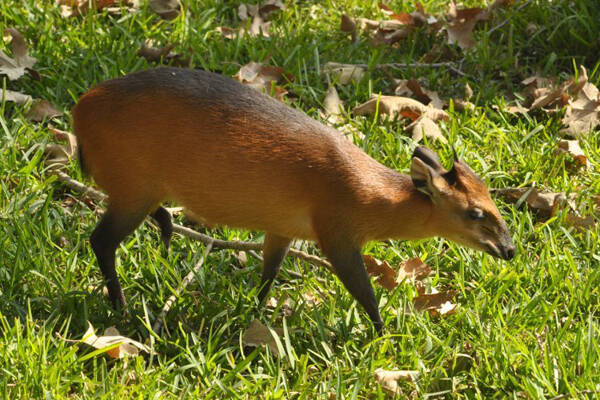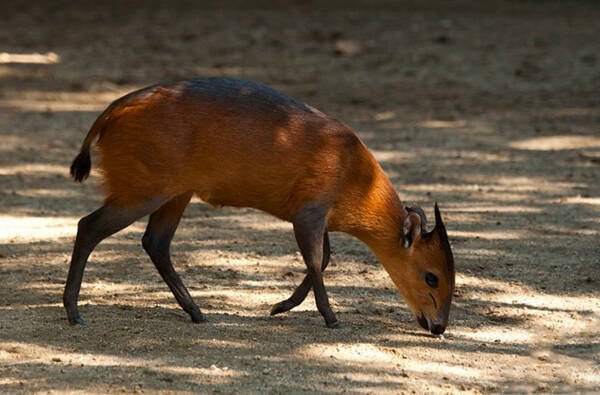Cephalophus rufilatus
IUCN
LCBasic Information
Scientific classification
- name:Cephalophus rufilatus
- Scientific Name:Cephalophus rufilatus
- Outline:Ungulata
- Family:Artiodactylus Bovidae Gazella
Vital signs
- length:60-70cm
- Weight:9-14kg
- lifetime:About 15 years
Feature
Flame-marked face, large ears, and a tuft of black hair on a dark forehead
Distribution and Habitat
Distributed in Benin, Burkina Faso, Cameroon, Central African Republic, Chad, Democratic Republic of Congo, Côte d'Ivoire, Gambia, Ghana, Guinea, Guinea-Bissau, Mali, Niger, Nigeria, Senegal, Sierra Leone, South Sudan, Sudan and Togo.
Suspected extinct: Uganda.
The red-rumped duiker is a species that inhabits the savanna woodlands of West and Central Africa. It thrives along the transition zones and drainage lines of savanna forests. These habitats are characterized by tall grasses (primarily elephant grass, pennisetum) and shrubs (caperaria, arborescens, and others) and provide ample grazing opportunities and suitable cover. In Sierra Leone, the species was once the most common duiker in northern savannas and on the fringes of farm shrubs in the south; its range was replaced by farm shrubs and other secondary vegetation, allowing the species to expand southward to some extent.
Appearance
The Red-rumped Duiker is 60-70 cm long, 30-40 cm tall at the shoulder, and 7-10 cm long tail. Adults weigh 9-14 kg. It is a stocky, rounded-backed small antelope. The body is bright fox-red, with a layer of orange-red fur on the sides and lighter fur on the ventral side. They have a dark gray-black stripe running down the midline of their back from the shoulders to the hips. The calves are also blue-gray below the ventral line, as is the tail, which has a tuft of black fuzz on the tail. A black flame runs down the center of the face, the muzzle and lower lip are dark, and the upper lip and lower jaw are white. The ears are large, with a tuft of black hair on the dark forehead. A very prominent slit in front of each eye is the opening of the preorbital gland. Adult males have short, black, spike-like horns that protrude directly back from the forehead, 6-9.5 cm long. Females usually have much shorter horns than males, 3-4 cm long, or none at all.
In general, animals of the genus Stee
Details
Red-flanked Duiker (scientific name: Cephalophus rufilatus) is called Red-flanked Duiker in English, Céphalophe à Flancs Roux in French, Blaurückenducker and Rotflankenducker in German, and has no subspecies.

In the wild, red-rumped duikers occupy different habitats that rarely overlap. They live alone or in pairs within a specific home range. Occasionally, more of the same species are found around water sources. Red-rumped duikers mark their feeding areas with scent secretions from the preorbital glands. These habitats are small compared to other antelopes and are occupied for several months before abandoning and moving into new territory.
Red-rumped duikers have acute hearing and senses of smell that are superior to humans, which can make observing red-rumped duikers challenging. When they feel threatened, they emit piercing barks to communicate with their young. Red-rumped duikers are also sensitive to territorial scent markings of other species.
Red-rumped duikers are most active in the early morning and evening, and they spend most of their time foraging for food. Red-rumped duikers are relatively solitary animals, staying in the same habitat for several months before moving to a new territory. When feeding, they are constantly alert and can be easily provoked into escape behavior. They will lower their heads and dive into nearby vegetation when startled. Unlike other duikers, red-rumped duikers do not engage in social games or mutualism. Both of these behaviors are common in other species of the genus Duiker.

Red-rumped duikers are herbivores and have been described as "lawn mowers". They primarily feed within a meter of the ground and do not spend a large amount of time in any one area. Food consists mainly of leaves and fruits, but also includes flowers and branches. In a study of the stomach contents of red-rumped duikers, it was shown that they prefer to feed on fruits in patches of secondary forests in moist savannas.
The mating behavior of red-rumped duikers is not well described in the literature. However, mating behavior is relatively homogeneous among species of the genus Duiker. Courtship is characterized by males following, biting, and licking the female's genitals from a few days before estrus (lasting one day) until mating. During estrus, female duikers squat unusually low to urinate. Female urine evokes a reaction in which males wrinkle their upper lips in a distinctive grimace when urine detects pheromones. Female duikers display sexual receptivity by swelling and reddening of the vulva.
The mating system of red-rumped duikers is monogamous. Among male duikers in captivity, competition for mates takes the form of charging, aggressive chasing, head-butting, and biting. Competitive aggression between males has not been observed in the wild, probably because the home ranges of individuals are usually far apart. Gestation period 240-245 days, litter size 1, calf weight at birth averages about 1000 g. Weaning period 3 months. Female red-rumped duikers mark their young with secretions from the preorbital glands directly after birth and during grooming. Juveniles have been seen in the wild during the dry season or early rainy season. After the calf is born, the mother hides the calf in the vegetation for cover and then returns to feed it. At this stage, the calf will instinctively remain quiet even if other animals approach. The calf weighs about 9 kg when it is weaned and lives independently. Females reach sexual maturity at 18 months. Lifespan up to 15 years.

In 1999, the total number of the species of red-rumped duiker was estimated at 170,000, of which about half were in protected areas. Density estimates published in 2013 ranged from 0.1-4 per square kilometer. A 2001 reconciliation report said the number in Comoé, Ivory Coast, had fallen to 0.45-0.14 per square kilometer. In 2005, the density in Guinea was 2.6 per square kilometer, a decrease of 50%.
Listed in the IUCN Red List of Threatened Species in 2016 ver3.1 - Least Concern (LC).
Protect wildlife and eliminate game.
Maintaining ecological balance is everyone's responsibility!








